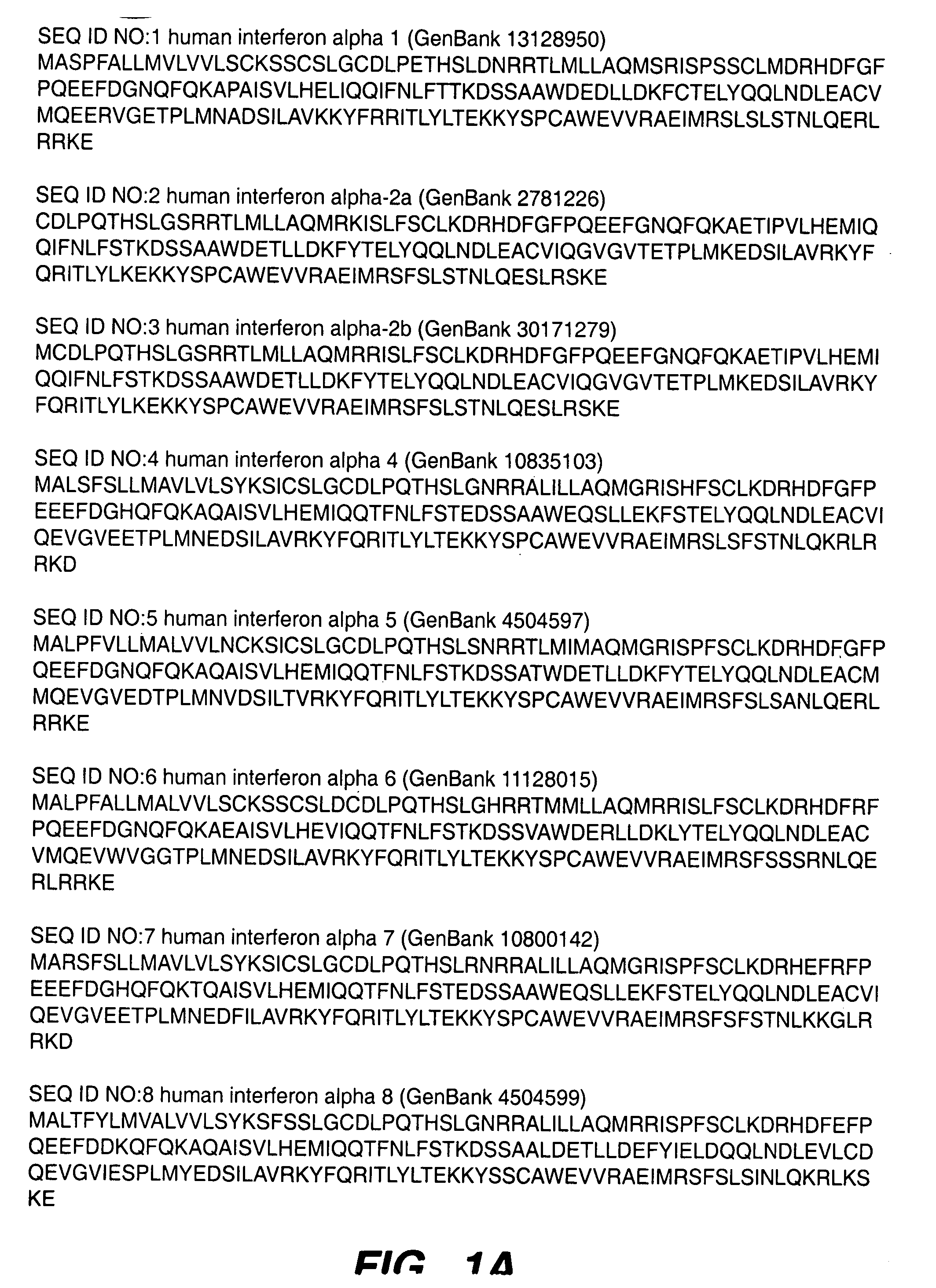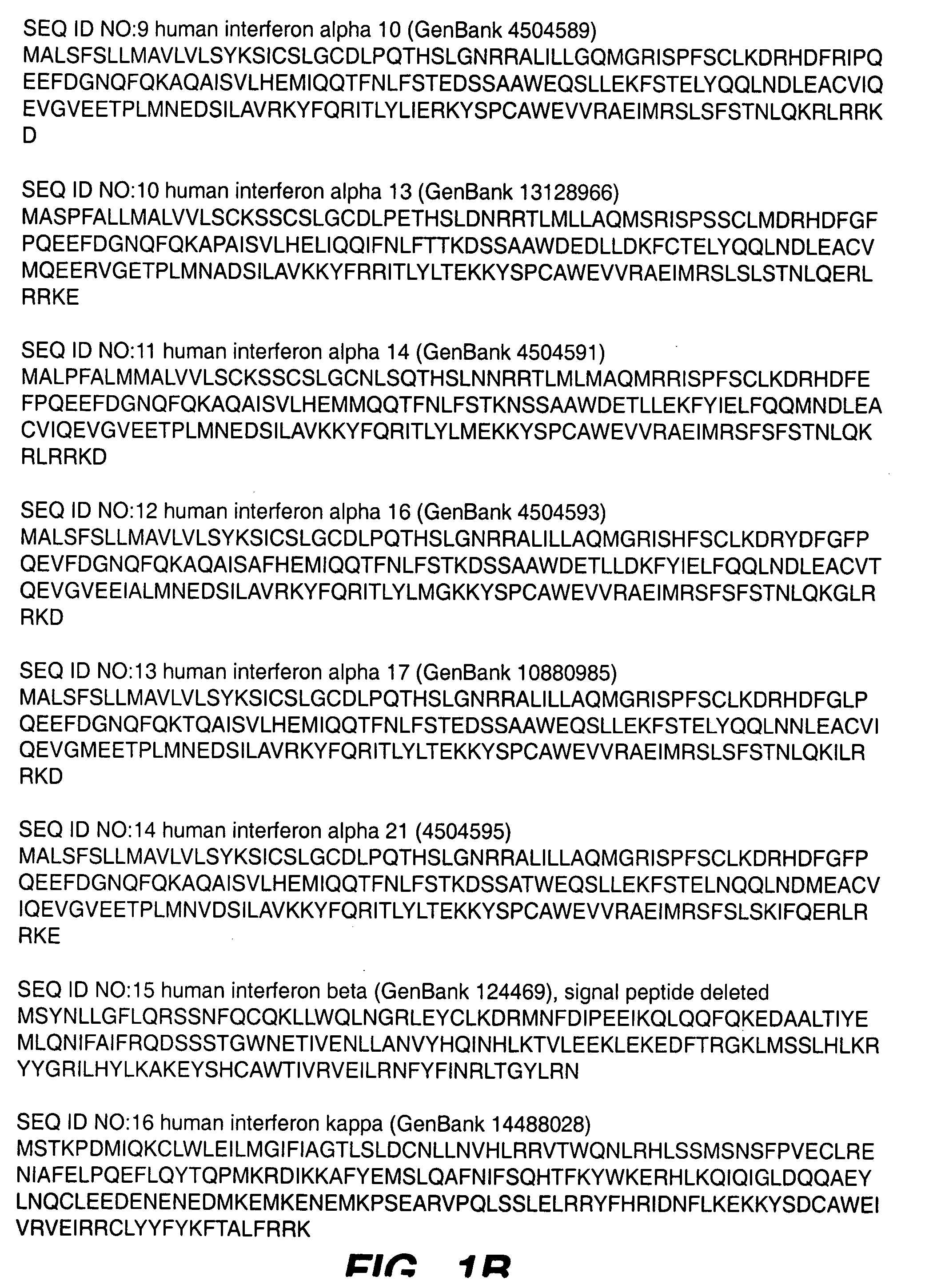Interferon variants with improved properties
- Summary
- Abstract
- Description
- Claims
- Application Information
AI Technical Summary
Benefits of technology
Problems solved by technology
Method used
Image
Examples
example 1
Construction of a Homology Model of Interferon Kappa
[0257] A homology model of interferon kappa was constructed based on the sequence of human interferon kappa (GenBank code 14488028), the crystal structures for interferon tau (PDB code 1BL5) and interferon beta (PDB code 1AU1), as well as the NMR structure for interferon alpha-2a (PDB code 1ITF). The sequences for interferons alpha-2a, beta, kappa, and tau were aligned using the multiple sequence alignment tool in the Homology model of the InsightII software package (Accelrys), as shown in FIG. 2. As the sequences share only approximately 35% identity, slightly different sequence alignments could have been used instead (see for example LaFleur et. al. J. Biol. Chem. 276: 39765-39771 (2001)). Based on similarity to the other interferon sequences, disulfide bonds are expected to be formed between residues C3 and C102 and between residues C32 and C155 (LaFleur supra); these disufides were used as constraints in the generation of the ...
example 2
Identification of Exposed Hydrophobic Residues in Type I Interferons
[0258] A number of type I interferon structures were analyzed to identify solvent-exposed hydrophobic residues. The absolute and fractional solvent-exposed hydrophobic surface area of each residue was calculated using the method of Lee and Richards (J. Mol. Biol. 55: 379-400 (1971)) using an add-on radius of 1.4 Å (Angstroms). Each residue was also classified as core, boundary, or surface (see Dahiyat and Mayo Science 278: 82-87 (1997)).
[0259] Solvent exposed hydrophobic residues in interferon-alpha 2a were defined to be hydrophobic residues with at least 75 Å2 (square Angstroms) exposed hydrophobic surface area in the interferon alpha-2a NMR structure (PDB code 1ITF, first molecule).
TABLE 1Exposed hydrophobic residues in interferon-alpha 2a.core / exposedboundary / hydrophobicpercent hydrophobicresidue#surfacesurface areaarea exposedMET16surface93.9044.50PHE27surface172.1069.10LEU30surface84.2039.40TYR89surface80.0...
example 3
Identification of Dimer Interface Residues in Type I Interferons
[0264] Potential sites of interactions between interferon monomers were identified by examining contacts between monomers in the crystal structures of interferon molecules.
[0265] Interferon alpha-2b crystallized as a trimer of dimers (PDB code 1RH2), in which the dimer interface is zinc-mediated (see Radhakrishnan et. al. Structure 4: 1453-1463 (1996)). The zinc-mediated dimer is referred to herein as the “AB dimer”, while the interface between AB dimers is referred to as the “BC” dimer interface. The zinc-binding site comprises the residues Glu 41 and Glu 42. Additional residues that have been implicated in stabilizing the AB dimer interface include Lys 121, Asp 114, Gly 44, and Arg 33 (Radhakrishnan, supra).
[0266] Next, distance measurements were used to identify additional residues that may participate in intermolecular interactions. Residues that are within 8 Å (Angstroms) of the AB dimer interface (as measured b...
PUM
| Property | Measurement | Unit |
|---|---|---|
| Solubility (mass) | aaaaa | aaaaa |
| Immunogenicity | aaaaa | aaaaa |
Abstract
Description
Claims
Application Information
 Login to View More
Login to View More - R&D
- Intellectual Property
- Life Sciences
- Materials
- Tech Scout
- Unparalleled Data Quality
- Higher Quality Content
- 60% Fewer Hallucinations
Browse by: Latest US Patents, China's latest patents, Technical Efficacy Thesaurus, Application Domain, Technology Topic, Popular Technical Reports.
© 2025 PatSnap. All rights reserved.Legal|Privacy policy|Modern Slavery Act Transparency Statement|Sitemap|About US| Contact US: help@patsnap.com



